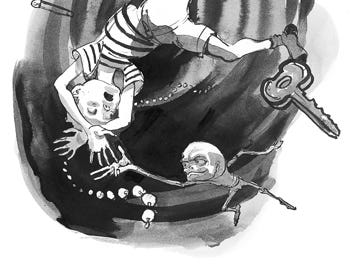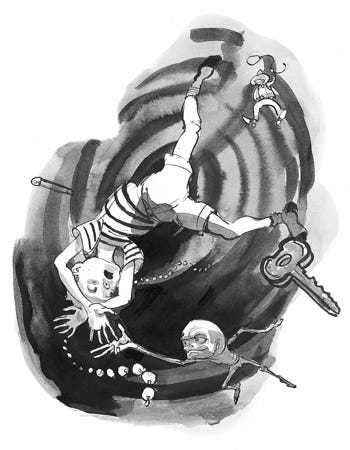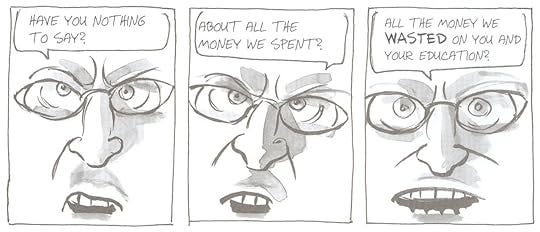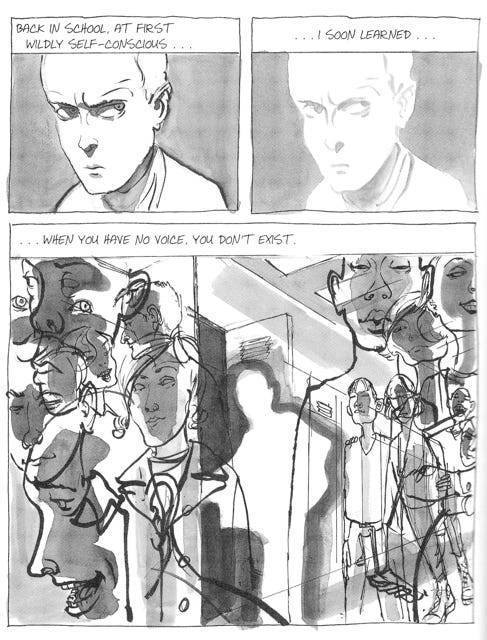i. introduction ★
A blanket, constantly suffocating you — choking your throat, pushing you face-down into the snow, until the only sound you can make is “…Ack.” A story about a dysfunctional middle-class family in Detroit; a pair of unloving parents, a boy with an illness, and a sinister silence that leaves you dreading every coming second. It’s subtly grotesque and horrifying, but it captivates you like a car accident that you can’t look away from. A volcano waiting to erupt, its tremors rumbling through your bones — but it never explodes.
Stitches is a graphic novel and memoir written by David Small, an American writer and illustrator most known for his children’s books. It is powerful and moving, and captures the essence of his abusive childhood in such a nuanced and terrifying way that I just had to talk about it. I’m a sucker for pretty art styles; gorgeous colours and neat lines, straight out of a watercolour painting. But this book? It had the most ugly art I’ve ever seen: washed out greys, untidy lines, distorted and grotesque facial expressions.
And it’s beautiful. Every detail in this artwork is intentionally used to convey that, yes, this story is a dark and ugly one. Every character is unlikeable, their personalities brought to life through exaggerated, hideous images; yet, they are handled with complexity, and even empathy.
It’s best to go into this book without knowing too much, so I will keep this review as spoiler-free as possible. And, hopefully, inspire you to pick it up as well.
ii. silence ★
Mama had her little cough… once or twice, some quiet sobbing, out of sight… or the slamming of the kitchen cupboard doors. [Whap! Whap! Whap!] That was her language.
Right from the very first line, David Small establishes the atmosphere in his house; he introduces each person’s “language”, the quiet ways in which they express their pent-up frustrations. This idea of suppressing all emotions and denying any form of open communication forms an important theme throughout the story. He feels voiceless, unheard, and out-of-control — literally, as a result of his medical treatment which removed his vocal cord, and figuratively, because of his oppressive and abusive parents.
The stitches on his neck from the medical surgery are a visual representation of the loss of his vocal cords; they symbolize this oppression he experiences, and the lack of any emotional connection within his family. We see how his parents repeatedly hide information from him, from important details about his severe medical illness, to their own personal, hidden lives. They cut him off, smother his voice completely, so that they wouldn’t have to deal with him.
One particular scene that highlights this was when David and his mother visited his grandparents’ house (I still get chills thinking about it). Just like any other six-year-old, David did not want to eat his meager and dry supper. He did not want to go to bed early, and he did not know how to change the sheets. His punishment? Being dragged up the stairs by his small wrists, and having his hands scorched by boiling water under the bathroom tap by his furious grandmother. The helplessness of his small, frail body, the smirk on his grandmother’s face as she watched him scream, his bare legs sprawled on the tiled bathroom floor — all these visuals drive home the cruelty of his upbringing. Almost the entire scene was conveyed in a series of silent panels; no dialogues and no words, just a loud silence that hummed beneath every page, threatening to swallow you whole.
Even more shocking, arguably, was the denial of his voice that followed. In tones of a softer, gentler grey, we see David trying to open up to his mother that same night about the incident. For the first time, we see a sign of vulnerability between the two, and a weak hope that maybe, this time, his mother would protect him. Instead, she grabs him angrily, her mouth upturned and her hair wild with fury, the panel immediately turning darker with a thicker and more intense stroke weight. She puts her hand over his mouth and tells him to never again mention his grandmother’s “crazy” actions. Silent once more, David lies with his eyes open that night, comparing his little room to a suffocating coffin.
iii. denial ★
You’ve been living in a world full of nonsense, David. No one has been telling you the truth about anything. But I’m going to tell you the truth.
Are you ready?
Your mother doesn’t love you.
His whole life, David learnt how to keep quiet, hidden. The reality of his family situation was a carefully fabricated lie that they all greedily swallowed, wanting to suppress any crack in their relationship. In the second half of the book, David is taken to a psychologist (a waste of money, according to his mother) where he finally faces the truth after fifteen years of denial.
Your mother doesn’t love you.
For the past two hundred and fifty pages, there is this persistent and unspoken sense of terror, where no one in the family ever acknowledges that something may be wrong. Everything that’s discomforting is brushed off and buried deep into the grave. David was constantly left on his own to fall into pieces, misheard, misunderstood. His parents dreadfully neglected his medical health, and consistently berated him when they, in fact, had done way worse. In this scene, we finally see an adult that not only seems to care about David’s well-being like a true parental figure, but one who finally lends a voice to his long-suppressed fears.
The silent panels that follow are some of the most memorable and hauntingly beautiful ones from the entire book, a testament to Small’s mastery over storytelling. Folding onto the floor and holding on to his psychologist’s leg for comfort, David starts to cry. His tears transform into a rainstorm, pouring down on the city streets and parking lots and factories, over lawns and driveways, reflecting off the windows and the hallways and the balconies, before returning back to an empty street and slowing down — into a single water ripple. A gentle, circular wave, that slowly fades away with the last teardrop. In a full page panel, we can feel him breathing in with his eyes closed, a moment of tranquility after the storm has passed.
No matter how hard I try, words will never truly capture the beauty of the panels here. After all, there are no words and no dialogues; just a gentle relief from all the pent-up rage and anger that had crawled its way underneath our skins. And it’s the most haunting, aching, loving, devastating thing that you could ever read.
Small also does something very interesting with the psychologist here — he’s not a human being. The psychologist is portrayed as a personification of the White Rabbit from Alice in Wonderland, complete with his little pocket watch that dictates when each session is over. Earlier in the book, we see six-year-old David wrapping a yellow towel around his head to play as Alice, the fictional character he had fallen in love with, with her long, blonde hair. Alice was his escape when he had no one else, when all the neighborhood kids would call him slurs and chase him away. This reference is never made again, until the psychologist. I’m not sure what it could mean here; perhaps the psychologist was his escape from his cruel home, where he finally had someone to talk to and open up with. A fictional character built around magical falsehoods, here to help him make better sense of reality and truth. A little ironic, but certainly very interesting, and possibly a suggestion on the importance of fiction in understanding our own lives better.
iii. human ★
Before the cruel scene that passed between David and his grandmother, we are introduced to her past as a young, carefree woman who struggled to be accepted into her husband’s family. They had to elope, her husband died when her daughter (David’s mother) was ten, and her in-laws treated her terribly. Before the readers can even pass judgement on her abusive nature in old-age, we see a very human side of her story.
Likewise, David doesn’t introduce himself as a pitiable young boy; in fact, he is initially shown as a bratty, spoilt six-year-old kid, who deliberately causes trouble to spite those around him. But the readers soon understand his loneliness and abuse, as he provides us with a window to glimpse into his life at home. We also briefly see a part of his mother, hidden away in secret suffering – though I will spare the details ‘cause spoilers.
No person in this book is represented through a one-dimensional lens. Yes, they can be terrible and difficult people, but it’s not the only part of them that exists. Although it doesn’t justify any of their actions, it does portray the story in a very humanizing and vulnerable way. Just another testament to how powerful this story is.
iv. hope ★
Suddenly I realized the building was the one where grandma had been locked away. The old central state asylum. The figure was my mother, sweeping the path, clearing the way for me to follow…
I didn’t.
Now thirty years old, David returns home after visiting his dying mother at the hospital. We see him driving in a small car, as Mrs. Small once did. With his hair short and unruly, and his jaw clenched, we see an uncanny resemblance between the two.
Is he becoming what he feared most?
The dread doesn’t end there. The last scene describes a strange dream he has, where his mother is beckoning him to follow his family’s path towards insanity and destruction. His entire family had collapsed, the walls built over these years finally crumbling down.
“I didn’t.”
But in the end, David reclaims his identity for himself, not letting his past define him or what he does. Breaking free from his generational trauma, we see him settling into the stability of a successful career. It’s a bittersweet ending, but one that remains hopeful for the future.
v. conclusion ★
I wish I could cover even more things about this book, but I’m afraid it’s already gotten too long. There is so much more to talk about: the hidden details, the foreshadowing, the way the dialogue and composition is beautifully used to emphasize the story, the transitions that feel like a moving film camera in your mind, the powerful symbolism, and the clever and subtle irony to show the true hypocrisy and neglect of David’s parents. But I will leave this for you to discover on your own :)
When I finished this book, I was left speechless. A thought flashed across my mind, “What in the world did I just read?” And I mean this in the best way possible. It was a whole experience, a world that sucks you in and chokes you with its rawness and vulnerability. I strongly urge anyone looking for a powerful, dark story to pick up Stitches. Easily, this was the best read of the year.
Thank you for reading! Since I created my Substack account a few weeks ago, I was stuck on what I could write about for my first post, until I read this book. My thoughts were too strong to let them go, and so I immediately went back to re-read it and write this article. If you liked this post, subscribe to receive updates. Feel free to drop your opinions or suggestions in the comment section!







im coming to your house now in the middle of the night and stealing this book from your bed-side table so i can read it because i don't think i can wait till monday : P
love the analysis ; )
MORE PLEASE 😩 🙌 😇